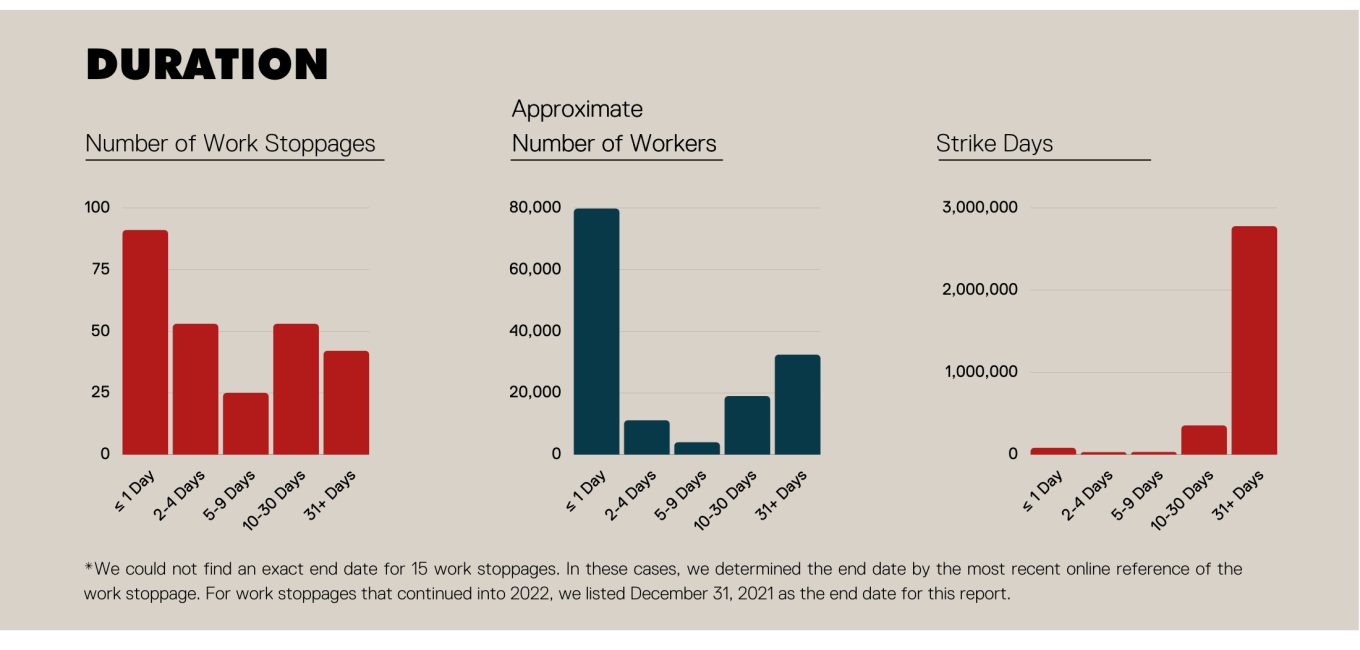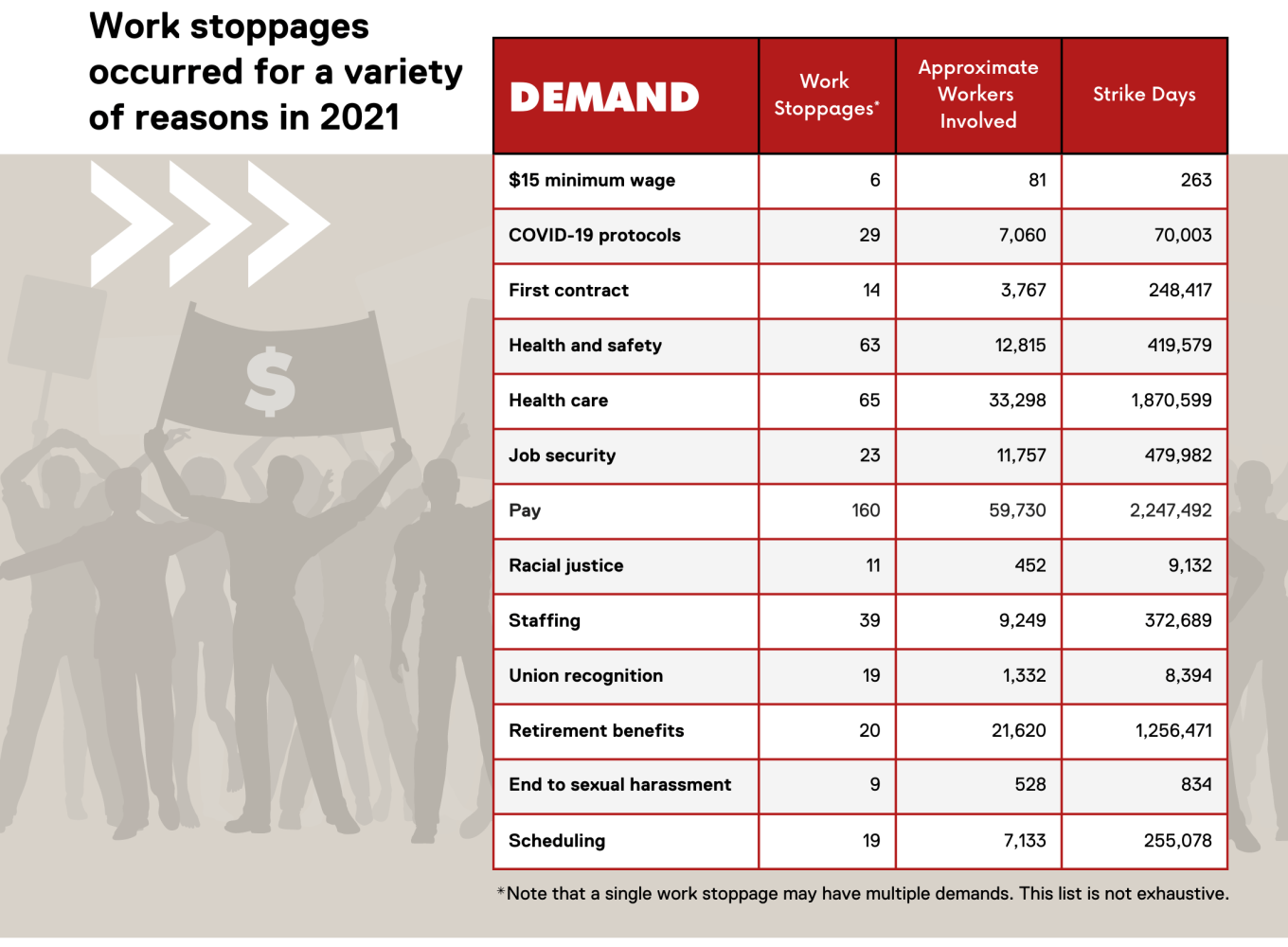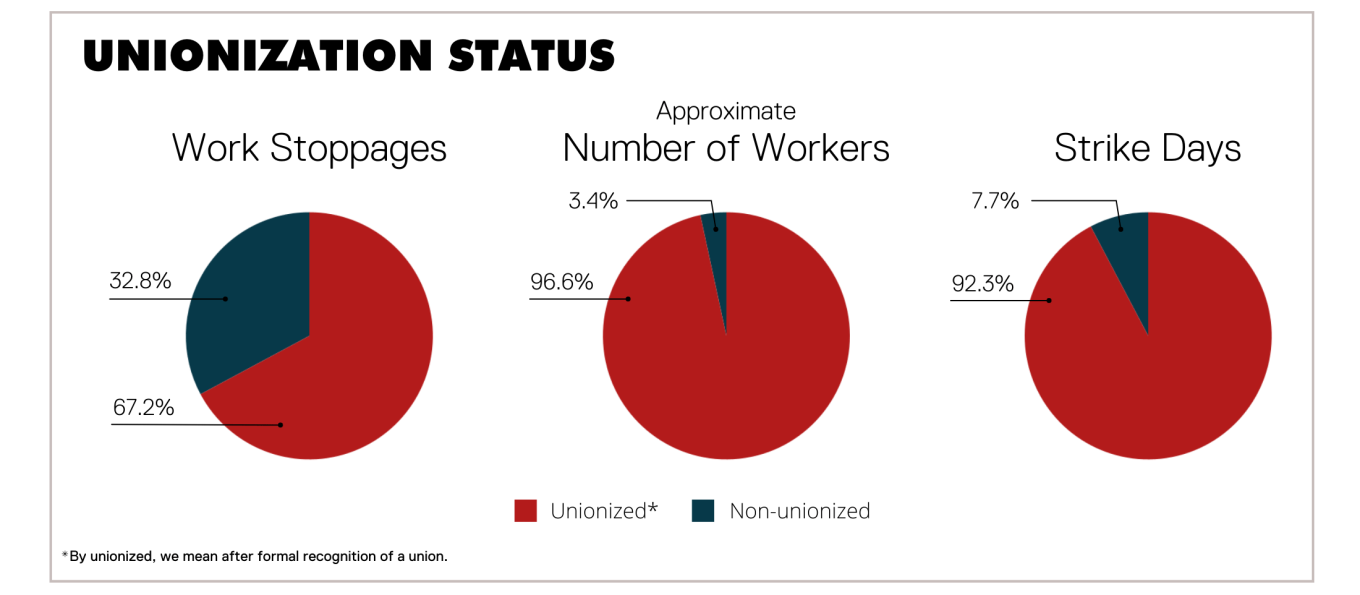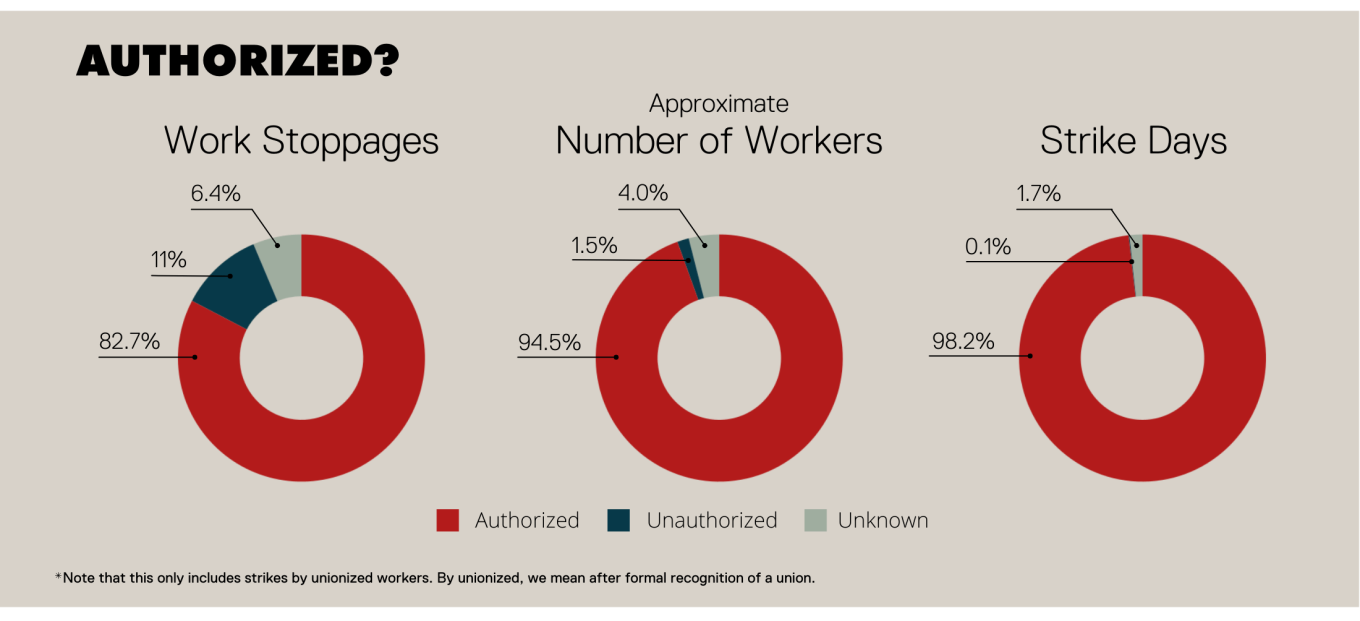Labor Action Tracker
Annual Report 2021
Johnnie Kallas, PhD Candidate, Cornell University ILR School
Leonardo Grageda, MILR ’22, Cornell University ILR School
Eli Friedman, Associate Professor of International & Comparative Labor, Cornell University ILR School
Introduction
2021 was a dramatic year for the US labor movement, with an upsurge in strike activity that gained extensive media attention. In light of ongoing speculation about the scope of these actions, we are particularly pleased to release the first ILR Labor Action Tracker Annual Report, which presents key findings from our data on work stoppages in 2021. We have created a comprehensive database of strikes across the United States because official data sources only record a small fraction of this activity. Since funding cuts by the Reagan administration in the early-1980s, the Bureau of Labor Statistics (BLS) only documents very large work stoppages - those involving 1,000 or more workers that last at least an entire shift. As this report demonstrates, only recording very large work stoppages excludes the vast majority of strike activity and leaves practitioners, policymakers, and scholars misinformed about the true level of workplace conflict. Strikes remain an important source of labor activism (and may be increasing in salience), as workers collectively stop work to address a range of demands, including, but not limited to, pay, health and safety, and racial justice. In this report, we follow the lead of the BLS and document work stoppages, which include both strikes and lockouts. You can follow our project and view our monthly reports of strike activity on Twitter @ILRLaborAction.
Methodology
This report is based on data we collected on strikes and lockouts in 2021. Detailed information on our project’s methodology can be found here. Further details specific to the methodology for this report can be found throughout this document. We generate all of our data on strikes from a number of public sources, including existing work stoppage databases, news articles, and social media posts. We follow rigorous verification protocols to ensure that a strike did in fact occur and to collect data on a number of related variables, including, but not limited to, the size, duration, industry, and demands of a strike. We link to the sources used to generate data on each strike on our site’s interactive map. We also collect data on labor protests, but only provide summaries of work stoppages in this report because our count of protests is less comprehensive. In light of our rigorous protocols, we may underestimate the total amount of work stoppages as we cannot include events that do not have adequate verifiable information.
Key Findings
We documented 265 work stoppages involving approximately 140,000 workers in 2021. These 265 work stoppages resulted in approximately 3,270,000 strike days this past year. Several interesting findings emerge from our 2021 data. First, the amount of work stoppages and the approximate number of workers involved in work stoppages increased considerably in October and November of 2021, indicating that, relative to the rest of 2021, ‘Striketober’ reflected a meaningful change in the level of strike activity across the United States. Second, we documented a surprisingly even distribution of work stoppages across the Northeast (70), the South (71), and the West (74). Third, we documented 87 strikes by nonunion workers, accounting for a somewhat unexpected 32.8% of the total number of work stoppages. This finding suggests that nonunion workers are organizing strikes despite lacking formal union recognition, though these strikes tend to be far smaller than work stoppages involving unionized employees. More data on work stoppages by month, industry, duration, size, demands, unionization status, authorization status, and geography can be found in this report.
Finally, while we documented an uptick in strikes and approximate number of workers on strike in October and November 2021, the level of strike activity is lower than earlier historical eras. The number of work stoppages and approximate number of workers involved in work stoppage is considerably less than the most recent comprehensive BLS data from the 1970s, and the approximate number of workers involved in work stoppages falls behind recent increases documented by the BLS in 2018 and 2019. More research is needed to make meaningful historical comparisons that account for the immense challenges facing striking workers and the labor movement more broadly.
Acknowledgments
A special thanks goes to the Cornell ILR School for funding our project and the entire ILR Labor Action research team for putting in the hours to document strike activity. We thank the staff at Cornell ILR’s Worker Institute, who have continued to support and promote our project since our public launch in May 2021. We would also like to thank David Yantorno and Betsy Wiggers of ILR’s marketing team, Mary Catt of ILR’s communications team, and David DeMello of ILR’s web development team for their excellent design and promotion of our report.

Number of work stoppages and approximate number of workers involved in stoppages per month
In 2021, approximately 140,000 workers were involved in 260 strikes plus five lockdowns, for a total of 3,269,186 total strike days. Work stoppages increased steadily throughout the year and reached peak numbers in October and November.


Labor action by industry
Manufacturing and educational services accounted for the majority of total work stoppages: 17.7% each. Workers in the health care and social assistance industry comprised over half of all workers involved in stoppages in 2021, due mostly to two large one-day sympathy strikes in California. Workers in manufacturing had the largest number of strike days, at 35.8% of all strike days combined.

Labor action by duration
A slight majority of work stoppages in 2021 lasted four days or less. These relatively short strikes included the majority of workers. Although involving a smaller total number of workers, strikes longer than a month accounted for the overwhelming majority of total strike days.

Labor action by size
About half of the total 265 work stoppages involved fewer than 100 workers. Of the approximately 140,000 total workers involved in work stoppages, the vast majority participated in the 24 work stoppages that each involved 1,000 or more workers.

Labor action by demands
The most common demands of work stoppages involved better pay, health care benefits, and health and safety protocols.

Labor action by unionization status
Approximately two-thirds (67.8%) of work stoppages involved unionized workers. Just under one-third (32.8%) involved nonunion workers. Unionized workers comprised the vast majority of approximate workers involved in work stoppages, accounting for 96.6%. They also accounted for 92.3% of strike days.

Labor action by authorization status
82.7% of all unionized strikes* were authorized by a union, compared to 11% that were unauthorized and 6.4% with unknown authorization status. Authorized strikes comprised an even higher percentage of approximate number of workers and strike days, accounting for 94.5% and 98.2% respectively.

Labor action by geographic region
Work stoppages were nearly evenly distributed across the West, South, and Northeast, with the number in the Midwest falling slightly behind. The approximate number of workers involved in work stoppages in the West far outpaced the other three regions, largely due to the two very large one-day sympathy strikes in California. The greatest number of strike days were in the Northeast and the fewest were in the West.

Data
Table 1
2021 Monthly Work Stoppages and Approximate Number of Workers Involved in Work Stoppages
NOTE: A single work stoppage may appear in multiple months.
| 2021 | Work Stoppages | Approximate Number of Workers |
|---|---|---|
| January | 11 | 5,107 |
| February | 13 | 3,134 |
| March | 23 | 9,253 |
| April | 30 | 15,905 |
| May | 32 | 12,512 |
| June | 37 | 13,417 |
| July | 40 | 15,070 |
| August | 25 | 7,546 |
| September | 35 | 12,379 |
| October | 60 | 32,313 |
| November (two one-day sympathy strikes made up 62,000 of 90,561 approximate workers) | 60 | 90,561 |
| December | 41 | 21,794 |
Table 2
Industry of Work Stoppages
NOTES: A work stoppage may include workers from multiple industries.
Two one-day sympathy strikes make up a large percentage of health care stoppages.
| Industry | Work Stoppages | Approximate Number of Workers | Strike Days |
|---|---|---|---|
| Agriculture, Forestry, Fishing and Hunting | 1 | 100 | 200 |
| Mining | 2 | 1,700 | 449,500 |
| Utilities | 3 | 374 | 6,494 |
| Construction | 4 | 2,845 | 51,185 |
| Manufacturing | 50 | 25,202 | 1,234,234 |
| Retail Trade | 13 | 8,076 | 52,792 |
| Transportation and Warehousing | 30 | 1,894 | 24,943 |
| Professional, Scientific and Technical Services | 4 | 400 | 910 |
| Educational Services | 50 | 13,037 | 330,801 |
| Information | 17 | 5,008 | 661,868 |
| Health Care and Social Assistance | 34 | 73,471 | 511,575 |
| Arts, Entertainment and Recreation | 12 | 1,905 | 52,527 |
| Accommodation and Food Services | 25 | 644 | 4,620 |
| Public Administration | 19 | 5,565 | 48,009 |
| Administrative and Support and Waste Management | 12 | 1,930 | 12,700 |
| Other Services (except Public Administration) | 7 | 107 | 3,337 |
Table 3
Duration of Work Stoppages
NOTE: We could not find an exact end date for 15 work stoppages. In these cases, we determined the end date by the most recent online reference of the work stoppage. For work stoppages that continued into 2022, we listed December 31, 2021 as the end date for this report.
| Interval | Work Stoppages | Approximate Number of Workers | Strike Days |
|---|---|---|---|
| Less than or equal to 1 Day | 91 | 79,774 | 79,559 |
| 2 to 4 Days | 53 | 11,078 | 28,723 |
| 5 to 9 Days | 25 | 3,968 | 29,151 |
| 10 to 30 Days | 53 | 18,920 | 353,252 |
| 31 plus Days | 42 | 32,369 | 2,777,621 |
Table 4
Approximate Size of Work Stoppages
NOTE: Research gathered data on the number of workers involved in work stoppages for 238 out of 265 actions equals 90 percent.
| Number of Workers/ Stoppage | Work Stoppages | Approximate Number of Workers | Strike Days |
|---|---|---|---|
| 2 to 49 | 87 | 1,918 | 30,547 |
| 50 to 99 | 44 | 3,067 | 54,133 |
| 100 to 249 | 45 | 6,221 | 96,318 |
| 250 to 999 | 38 | 17,933 | 740,688 |
| 1,000 plus | 24 | 110,950 | 2,347,500 |
Table 5
Demands of Work Stoppages
NOTE: A single work stoppage may have multiple demands. This list is not exhaustive.
| Demand | Work Stoppages | Approximate Number of Workers | Strike Days |
|---|---|---|---|
| $15 minimum wage | 6 | 81 | 263 |
| COVID-19 protocols | 29 | 7,060 | 70,003 |
| First contract | 14 | 3,767 | 248,417 |
| Health and safety | 63 | 12,815 | 419,579 |
| Health care | 65 | 33,298 | 1,870,599 |
| Job security | 23 | 11,757 | 479,982 |
| Pay | 160 | 59,730 | 2,247,492 |
| Racial Justice | 11 | 452 | 9,132 |
| Staffing | 39 | 9,249 | 372,689 |
| Union recognition | 19 | 1,332 | 8,394 |
| Retirement benefits | 20 | 21,620 | 1,256,471 |
| End to sexual harassment | 9 | 528 | 834 |
| Scheduling | 19 | 7,133 | 255,078 |
Table 6
Union Versus Nonunion Work Stoppages
NOTE: By unionized, we mean after formal recognition of a union.
| Unionization Status | Work Stoppages | Approximate Number of Workers | Strike Days |
|---|---|---|---|
| Unionized | 178 | 135,405 | 3,017,400 |
| Non-unionized | 87 | 4,754 | 251,786 |
Table 7
Authorized Versus Unauthorized Work Stoppages
NOTE: This only includes strikes by unionized workers. By unionized, we mean after formal recognition of a union.
| Interval | Work Stoppages | Approximate Number of Workers | Strike Days |
|---|---|---|---|
| Authorized | 143 | 125,971 | 2,962,798 |
| Unauthorized | 19 | 2,032 | 3,451 |
| Unknown | 11 | 5,317 | 51,151 |
Table 8
Geographic Breakdown of Work Stoppages
NOTE: Two one-day sympathy strikes make up a large percentage of Western U.S.
| Region | Work Stoppages | Approximate Number of Workers | Strike Days |
|---|---|---|---|
| Northeast | 70 | 22,888 | 1,569,124 |
| Midwest | 58 | 20,900 | 592,754 |
| South | 71 | 12,104 | 869,018 |
| West | 74 | 83,752 | 254,695 |


